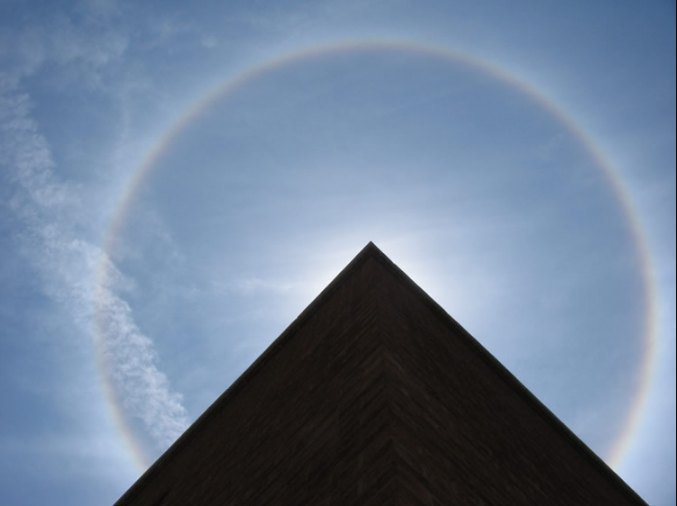Beneath the stars
Beneath the Stars: Unveiling the Wonders of Atmospheric Optics
Have you ever gazed up at the night sky, captivated by the twinkling stars? While our attention is often drawn to the celestial wonders above, there is a breathtaking world that exists just beneath the stars - the realm of atmospheric optics. In this article, we will delve into the mesmerizing phenomena that occur in our Earth's atmosphere, specifically focusing on the enchanting display known as ice halos.
Ice halos, such as the stunning circular halo captured by Krystal Tyler in the image above, are formed when sunlight interacts with ice crystals suspended in the atmosphere. These crystals can take various forms and orientations, resulting in a dazzling array of optical effects. One of the most common types of ice halos is the 22° halo, named after its approximate radius from the Sun. However, despite its frequency, the exact crystals responsible for producing this phenomenon remain somewhat of a mystery.
Traditionally, it was believed that 22° halos were formed by randomly oriented ice crystals. However, recent research has challenged this notion, revealing that true random orientations are not necessarily required for their formation. This intriguing revelation adds an extra layer of complexity to our understanding of these captivating halos.
In addition to the 22° halo, there are numerous other types of ice halos that can grace our skies. These include circumscribed halos, which are formed by horizontal columns of ice crystals. These halos often exhibit a striking circular shape and can be equally as breathtaking as their 22° counterparts. Each type of halo offers a unique visual spectacle, making the study of atmospheric optics a truly fascinating field.
To fully appreciate the beauty and diversity of ice halos, it is essential to observe them under specific atmospheric conditions. Typically, these conditions involve cold temperatures and high-altitude cirrus clouds. When these elements align, they provide the perfect canvas for the intricate interplay of sunlight and ice crystals, resulting in a mesmerizing display that enchants both scientists and sky gazers alike.
While we marvel at the beauty of ice halos, it is important to note that they are not merely aesthetic wonders. These optical phenomena serve as valuable tools for atmospheric scientists, providing insights into the composition and behavior of our atmosphere. By studying the formation and characteristics of ice halos, researchers can gain a deeper understanding of atmospheric conditions, such as the presence of high-altitude ice crystals and their impact on weather patterns.
As we delve deeper into the realm of atmospheric optics, we uncover a world brimming with wonder and complexity. The study of ice halos not only captivates our imaginations but also offers a glimpse into the intricate workings of our Earth's atmosphere. From the enigmatic 22° halo to the captivating circumscribed halo, each optical phenomenon serves as a reminder of the breathtaking beauty that lies just beneath the stars.
In conclusion, the study of atmospheric optics unveils a world that exists beneath the stars, where sunlight dances with ice crystals to create captivating displays known as ice halos. While the exact crystals responsible for forming the 22° halo remain elusive, recent research has shown that true random orientations may not be necessary for its formation. By observing these optical wonders under specific atmospheric conditions, scientists gain valuable insights into the composition and behavior of our atmosphere. As we continue to explore the mysteries of atmospheric optics, we are reminded of the boundless beauty and complexity that lies beneath the stars.

Circular halo imaged by Krystal Tyler. The sun is blocked by the Tucson, University of Arizona Astronomy Building. ©Krystal Tyler, shown with permission.
"..the wondrous world above
our eyes but below
the stars." Krystal.
The sun was 70° high when this ice halo formed in cold and high cirrus. It could have been a 22° halo or a circumscribed from horizontal columns. Whatever, it is beautiful.
22° halos are often ascribed to "random" oriented crystals but true random orientations are not needed. Surprisingly, for this the most frequent of all the halos, we do not know for sure what crystals produce it.
22° halo Gallery
Note: this article has been automatically converted from the old site and may not appear as intended. You can find the original article here.
Reference Atmospheric Optics
If you use any of the definitions, information, or data presented on Atmospheric Optics, please copy the link or reference below to properly credit us as the reference source. Thank you!
-
<a href="https://atoptics.co.uk/blog/beneath-the-stars/">Beneath the stars</a>
-
"Beneath the stars". Atmospheric Optics. Accessed on November 26, 2024. https://atoptics.co.uk/blog/beneath-the-stars/.
-
"Beneath the stars". Atmospheric Optics, https://atoptics.co.uk/blog/beneath-the-stars/. Accessed 26 November, 2024
-
Beneath the stars. Atmospheric Optics. Retrieved from https://atoptics.co.uk/blog/beneath-the-stars/.